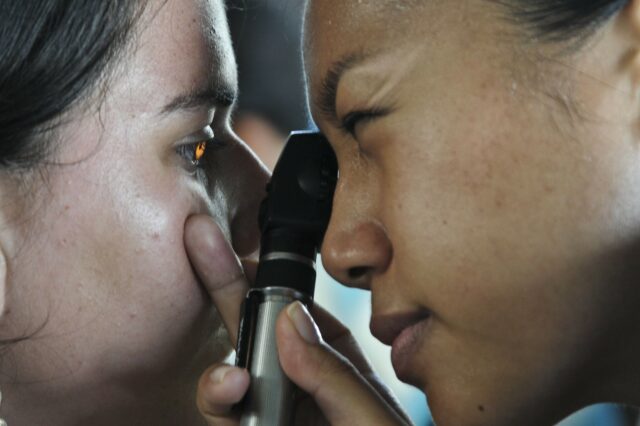Through the Lens of an Ophthalmologist: AMD Diagnosis and Treatment

Imagine waking up one morning and noticing images around you slowly starting to fade.
According to the American Society of Retina Specialists, more than 15 million Americans are affected by age-related macular degeneration, or AMD, also known as vision loss. This February, UF Health is highlighting the importance of AMD/Low Vision Awareness Month, as well as the remarkable strides that UF Health ophthalmologists have made toward combating this degenerative eye disease.
Who is affected by AMD and what are the symptoms?
AMD begins to show up in adults around age 50, and patients can be diagnosed with either wet or dry AMD. Whereas wet AMD requires eye injections or lasers to slow rapidly deteriorating eyesight, dry AMD weakens eyesight and is slowed through vitamin supplements.
“Patients with AMD may have difficulty focusing and may explain their eyesight as seeing through a patch of grey fog,” said Gibran Khurshid, M.D., a retina specialist in UF Health’s department of ophthalmology. Additional warning signs of AMD include difficulty with every day tasks, such as reading and putting on clothing.
Factors that contribute to developing AMD include a family history of AMD, as well as environmental factors such as sunlight exposure and smoking.
Improvements through Innovation
Recently, UF Health’s Sonal Tuli, M.D., M.Ed., a cornea-trained cataract surgeon and chair of the UF College of Medicine’s department of ophthalmology, embarked upon a new procedure to restore vision to those with AMD by implanting a 4.4-millimeter CentraSight telescope into the eye.
“Studies have shown the decrease in the quality of life for patients with end-stage AMD to be similar to that of a devastating stroke,” Tuli said. “The telescope implant has been shown to significantly improve the quality of life of these patients by allowing them to become more independent in their daily activities.”
Smaller than a pea, the telescope implant uses micro-optical technology to magnify images that would normally be seen in one’s “straight ahead” or central vision. These magnified images are projected onto the healthy portion of the retina not affected by the disease, making it possible for patients to see or discern the central vision object of interest.
Road to Recovery
Although there is no cure for AMD, there are ways to assist those with degeneration through the use of magnifiers, tinted glasses and digital devises. There are also organizations within the community that assist patients who are visually impaired with the resources they need to live more independent lives, including the Florida Division of Blind Services and ElderCare of Alachua County.
“Patients with the best outcomes have a strong family support system, have educated themselves about the impact of AMD, have a positive attitude and are motivated to get better,” said Jessica Cameron, O.D., an optometrist in UF Health’s department of ophthalmology.
About the author
